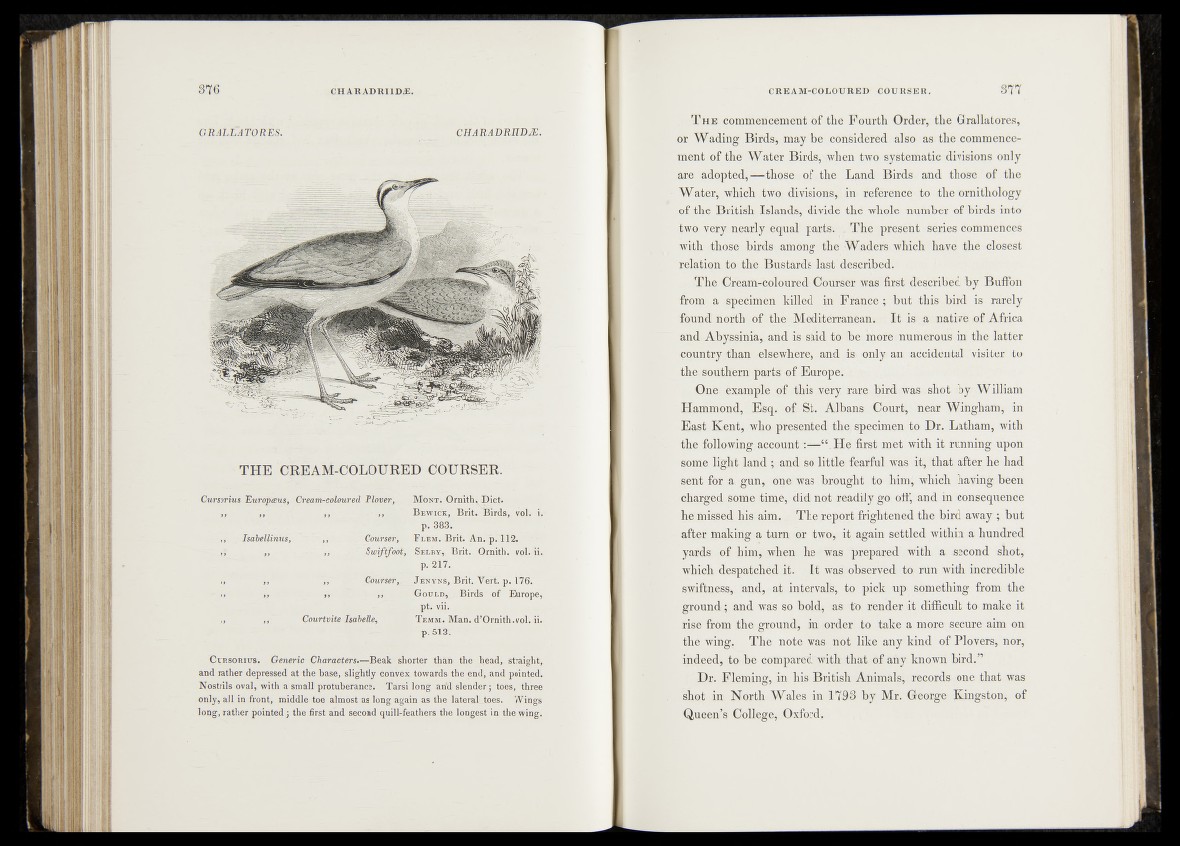
GRALLATORES. CHARADRIID/E.
T H E CREAM-CÔLOURED COURSER.
Cursorius Europaus, Cream-coloured Plover,
Isabellinus, , , Courser,
tf ,, ■ Swiftjföötj,
M ont. Ormthv J)ict.
B ewick, B rit.- B ird s , - vol.'-' i.-
p. 383.'
F lem . ?Bfit. |tn .tp ? l !l 2 . ’ ■
Selby,; . Brit. Ornitli .-?v(ol./i'i.
p.-217.
„ ,, ,, Courser,. . J enyns, Brit. Vert. p. Ï76.
„fa ~ ft it G ould, Birds of Europe',*
.. pt>. yjL
,, Courtvite Isabelle, T emm. Man. d'Oinith.iol. ii.,
p. 513.
- C urso-biu s . Generic Characters.—Beak shorter than the head, straight,
and rather depressed at the base, sligitljy Convex towards the end, and pointed.
Nostrils oval, with a small protuberances Tarsi long an*d slender; toes, three
only, all in front, middle toe almost as long again as the lateraljtoes. «dfcgst
long, rather pointed; the first and second quill-feathers the longest in the yping.
. T h e commencement of the Fourth Order, the Grallatores,
or Wading Birds, may be considered also as the commencement
of the Water Birds,\when two systematic divisions only
are adopted,—those of the Land Birds and those of the
Water; which two divisions, in reference^ the ornithology
of the British Islands; divide the whole number of birds into
two very nearly equal parts. . The ■ present series commences
wi th those birds among the W aders which have the closest
relation, to the Bustards last described.
- ',The Cream-coloured -Courser was first described by Buffon
from a r&bécimen killed in Francé f ^ u t . ^ i s bird is rarely
found north- of thé Mediterranean. It is ja native of Africa
and Abyssinia, and is said to Ibe inofeynnmerous in the latter
counfry than elsewhere;, and is> only an accidental visiter to
the, southern parts of Europe.
One èxample of this $èry rare bird, was shot Jay' William
Hammondv^q* of St.-..Albans;Court, near Wingham, in
East Kent^ who presented-thq specimen-tp Dr. Latham, with
the following:aeeojupt;>—“ .Hei,first mfet with it running upon
some light land ; and so little fearful .was it, that after he had
sent a gun, due was brought to hind which having been
charged some time, did not readily go! off, and in consequence
hOmissdd hfeaim. .^'The report-frightened the bird away ; but
after making-a turn or two, ii again settled, within a! hundred
yards of; him, when he- was prepared with a second shot,
which despatched it. It was .observed to; run with »credible
swiftness*, and, at intervals* to .pick up something from thé
- ground; and was so bold, as- to render it difficult to-makeill
rise from the ground, im;order .to take a more secure aim on
the, wing. The^&feM was not like any kind of Plover®; nor,
-indeed, to«jjb® compared"with that of any known bird/,r
Dr. Fleming, in his British,Animals,, records one that was
shot in North Wales* in 179&*iby Mr. George -Kingston*. of
Queen’s College, Oxford.